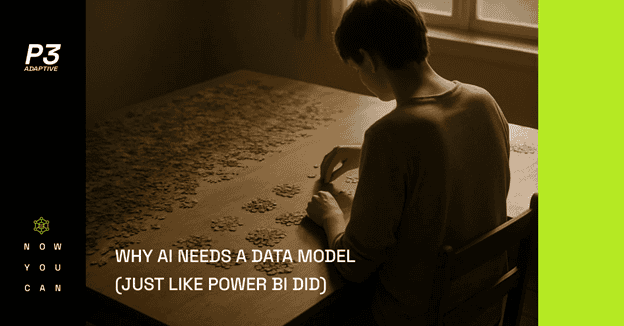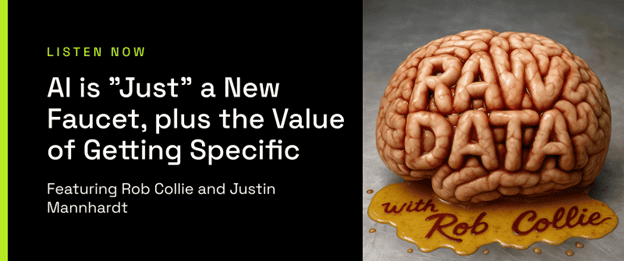
The Myth of the Magic Brain
Pet Peeve of the week: everyone treating AI like it’s some cosmic fortune teller that just knows things. Type a question, boom, instant genius. But look, if you’ve ever actually built a Power BI model, you’ve already seen through this illusion.
Real intelligence, the kind that actually gets stuff done, doesn’t spawn from mountains of raw data or massive neural networks. It comes from structure. From context. From relationships that make sense. You don’t make Power BI brilliant by drowning it in more spreadsheets. You make it brilliant by giving it a schema that reflects reality.
And here’s what’s wild: everyone’s missing this exact same truth about AI. It doesn’t need constant retraining every time it whiffs on an answer. It needs better framing. As Rob nailed it on the podcast: “You can’t change the AI—you just give it the right structure and context.” That’s not a bug. That’s the whole game.
Power BI Walked So AI Could Run
When Power BI dropped, it felt like alchemy. Reports practically assembled themselves. Dashboards refreshed before your coffee got cold. Pure magic, right?
Wrong. Behind the curtain, the real wizardry was semantic modeling. Those relationships, those measures, those hierarchies you spent hours building? That wasn’t grunt work? That was the foundation that made everything else sing.
Rob put it perfectly: “Even a Power BI model is just lightweight plumbing for intelligence.” That plumbing transformed meaningless numbers into actual meaning. And that meaning put real power in users’ hands.
Now we’re in round two. Same fundamental challenge, just with AI instead of dashboards. Questions written in plain English instead of DAX. The tools evolved, but the rules? Those stayed exactly the same.

Context Is the New Schema
Every time you “chat with your data,” here’s what’s really happening: the AI isn’t magically grasping your business logic, it’s frantically mapping your words to whatever model sits underneath. When that model is clean? The AI sounds like a genius. When it’s a mess? You get glorified fortune cookie responses.
The gap between brilliant and babbling isn’t about model parameters or training data volume. It’s about the context you feed it.
Which means, and this is the beautiful part, you don’t need to build your own LLM from scratch or burn months fine-tuning prompts. You just need to feed it better structure. The same kind of unified, governed, semantically rich foundation that made Power BI actually useful. You’re not teaching the model quantum physics here. You’re just giving it better directions.
The Next Great Modeler Isn’t a Data Scientist
Here’s the plot twist nobody saw coming: the people best positioned to make AI actually work aren’t holed up in AI research labs. They’re the same folks who made Power BI valuable five years ago.
They know what “profit” really means at your company: which version, which exceptions, which adjustments. They know why System A calls something a “customer” while System B calls it an “account” and System C just shrugs. That human context, the nuance no algorithm can reverse-engineer from patterns, is what transforms generic AI outputs into insights that actually matter.
If you’ve ever built a model that untangled someone’s nested-IF-statement nightmare and turned it into clarity, you already have the exact skillset to make AI better. You’re not teaching machines to think. You’re showing them how your specific corner of reality fits together. Semantic modeling didn’t just rescue reporting, it trained an entire generation to think structurally. That same mindset now unlocks AI alignment.
The Shortcut to AI That Actually Works
The fastest path to useful AI isn’t more training data or building custom models from scratch. It’s clarity. Full stop.
Skip the model-building arms race entirely. Start with structure instead. Feed your AI the same kind of clarity you’d feed Power BI: governed, connected, grounded in how humans actually understand the business. That’s how you turn a large language model into a large understanding model.
When you’re ready to ditch the hype cycle and build something that actually ships value, start with the foundation. Because once you get the model right, intelligence doesn’t need to be forced—it just flows.
If you’re ready to see what that looks like in your organization, reach out. We’ll help you get there faster, with the data and tools you already have.
Get in touch with a P3 team member